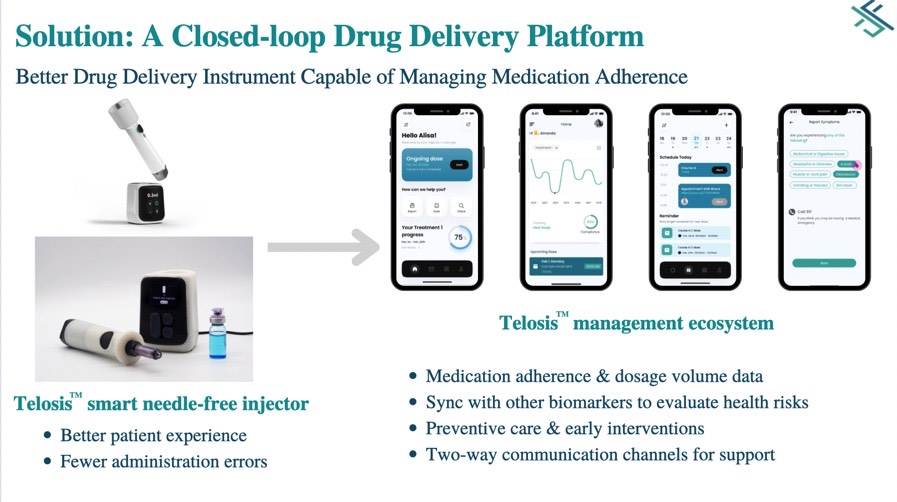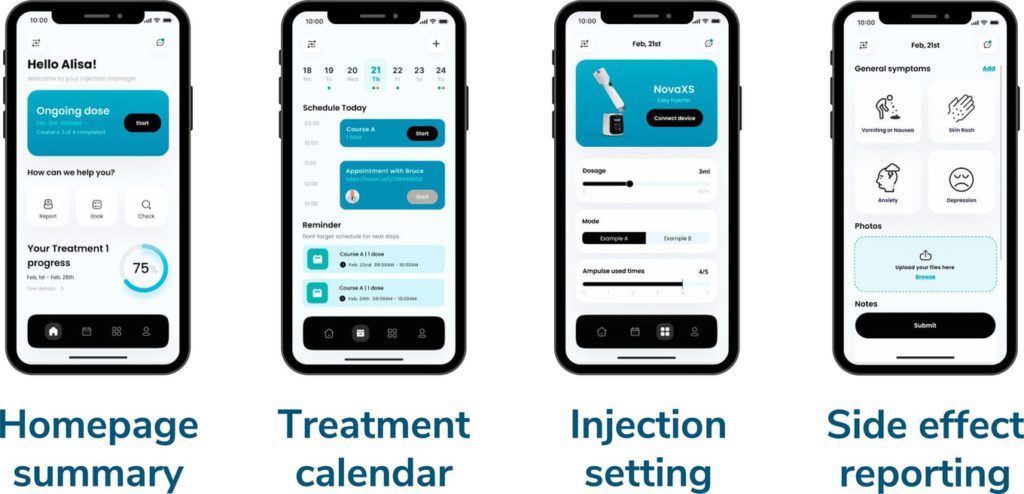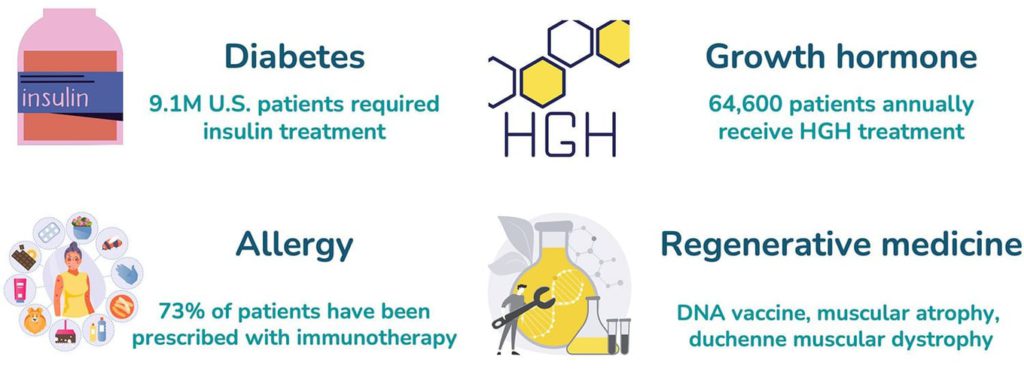To Issue 144
Citation: Su A, “Say “No More” to Needles: Needle-Free Self-Injection Technology for Painless, Better Care”. ONdrugDelivery, Issue 144 (Mar/Apr 2023), pp 16–18.
Alina Su discusses the need for improved and optimised remote healthcare to meet current challenges in the industry, and introduces Telosis, NovaXS’ patent-pending connected needle-free injection device that is poised to provide answers to these challenges.
Imagine being diagnosed with a chronic illness and learning that the only way to treat it is to inject your medication, often over a course of years. This is the case for millions of people worldwide, who face the pain, stress and confusion related to needle injection therapies. That’s why NovaXS, a smart medical device company, set out on a mission to make medication self-administration easy and accessible.
“A fear of needles, complicated treatments and lack of monitoring all add up to increased healthcare costs.”
THE PROBLEM: SELF-INJECTING TECHNOLOGY MEDICATIONS CAN BE UNCOMFORTABLE AND OVERWHELMING
Fear, pain and stress are emotions that people living with chronic illnesses, such as diabetes, infertility, allergies and growth hormone deficiencies, face daily due to their needle injection treatments. NovaXS is creating a better way to treat patients with chronic diseases by building a smart needle-free injection device called Telosis, which will be able to sync with a smartphone app.
When it comes to treating chronic conditions with injectable medications, there are three common points of friction for patients:
- Needle phobia: Needles can cause psychological fear and 80% of patients would prefer an alternative to needles due to the pain and skin irritation they cause.
- Complicated treatment management: Managing the whole self-injection process, from drug preparation to drug administration, can be complicated.
- Lack of treatment monitoring: There is a clear informational gap between providers and patients in remote healthcare settings, potentially leading to an increased risk of administration errors and low therapy adherence.
A fear of needles, complicated treatments and lack of monitoring all add up to increased healthcare costs. According to the US Centers for Disease Control,1 one in four adults and two in three children have a strong fear of needles and, according to the National Association of Chain Drug Stores,2 50% of patients do not take medications as prescribed. According to a Patient Safety Network study,3 the error rate of self-medication in at-home treatment is up to 33%, which means that up to a third of those who actually take their medications do not do it correctly. The consequences of this are real – pain, confusion, frustration, people not getting better and healthcare costs adding up.
THE SOLUTION: THE NOVAXS NEEDLE-FREE INJECTION SYSTEM
Over the last year, NovaXS has developed patent-pending technology, with the hope of introducing potentially life-changing drug delivery methods for injectable medications to the market to help treat chronic diseases and improve adherence. NovaXS aims to make at-home remote treatment monitoring possible through an advanced needle-free drug delivery platform. The technology is not exclusive to one type of treatment – NovaXS is developing solutions for patients with diabetes, infertility, growth hormone deficiencies, allergies and more.

Figure 1: The drug delivery platform includes automatic medicine-drawing and air-expelling technology, an external motor and vertical alignment with a safety lock.
“The NovaXS drug delivery platform, Telosis, consists of a smart
needle-free injection system that simplifies the medication self-administration process and improves remote treatment outcomes.”
The NovaXS drug delivery platform, Telosis, consists of a smart needle-free injection system that simplifies the medication self-administration process and improves remote treatment outcomes (Figure 1). Patients will be able to use Telosis to administer a narrow stream of medication without the need for a needle. The needle-free syringe uses liquid pressure to deliver medication into the subcutaneous or intramuscular space in just 0.3 seconds (Figure 2). The external motor design makes it possible for automatic medicine-drawing and air-expelling technology to simplify treatment preparation. The vertical alignment and safety lock prevent the medication from leaking and can minimise the pain associated with injections.

Figure 2: Telosis uses diffused absorption in its needle-free technology.
The medication administration process for NovaXS is:
- Draw medication from the vial
- Expel the air bubble in the cartridge
- Verify the dosage volume
- Administer the medication and track treatment progress with one simple click on the device.
“NovaXS integrates the medication adherence data collected from Telosis with other remote patient monitoring devices, such as wearable devices and glucose monitors, which can provide patients with the tools they need to take early interventions for preventive care.”
Physicians will be able to track their patients’ progress and analyse injection data to help patients make smarter health decisions. This all happens through integration with the Internet of Things (IoT) via a smartphone app. By including connectivity in this way, NovaXS can collect injection data, send patients reminders, monitor treatment progress and visual treatment calendars, and streamline communication between patient and physician to maximise remote healthcare adherence and prevent complications (Figure 3). Additionally, NovaXS integrates the medication adherence data collected from Telosis with other remote patient monitoring devices, such as wearable devices and glucose monitors, which can provide patients with the tools they need to take early interventions for preventive care.

Figure 3: NovaXS’s drug delivery platform includes an app that summarises treatment progress, treatment calendar, injection setting, side-effect reporting and more.
The smartphone app’s treatment calendar is generated based on the patient’s e-prescription and an injection reminder can be sent as a push notification to their phone prior to each injection. Injection data is collected by the device to inform healthcare providers of personalised treatment plans. Additionally, patients can communicate and report any side effects to their healthcare provider via their phone.
LOOKING TO THE FUTURE OF REMOTE DRUG DELIVERY
For chronic diseases that require frequent injections, remote healthcare is the clear trend for the future. Many companies are already taking steps to provide remote patient monitoring as part of their product offerings as they look to tackle staffing shortages and other challenges in today’s healthcare industry. However, NovaXS sees an opportunity for its platform to monitor and improve the adherence of these remote treatments. The company’s initial target therapeutic areas include diabetes, severe obesity, severe asthma, migraine, growth hormone deficiency and infertility, amounting to over 90 million patients in the US (Figure 4).

Figure 4: Nova XS is targeting markets including diabetes, growth hormones, allergies, regenerative medicine, infertility and others.
Looking towards the future, as insurance companies shift from pay for- visit to pay-for-outcome models, remote therapeutic monitoring codes are enabling the reimbursement of medical devices that collect remote therapy adherence data and deliver better care. Nowadays, over 21 million people undergo injection therapies. In 2021, the total available market size was valued at over US$620 billion (£502 billion).4 There is a clear trend that care providers and patients are looking for more convenient and effective delivery methods for injectable treatments that improve adherence and the patient experience. To meet this need, NovaXS’s approach emphasises a patient-centric approach to making self-injections easy and centres remote healthcare optimisation.
REFERENCES
- “Needle Fears and Phobia – Find Ways to Manage”. Centers for Disease Control and Prevention web page, accessed Jan 2022.
- Boylan L, “The Cost of Medication Non-Adherence”. National Association of Chain Drug Stores, Apr 2017.
- “Medication errors statistics 2022”. SingleCare, Jan 2022.
- “Injectable Drug Delivery Market Size, Share & COVID-19 Impact Analysis, By Device Type (Conventional Injectable, Pre-filled syringes, Autoinjectors, Pen Injectors, and Wearable), By Product Type (Freeze-dried Products, Injectable Sterile Products), By End User (Hospitals, Homecare Settings, Clinics, and Others), and Regional Forecast, 2020-2027”. Fortune Business Insights report, Jul 2020.

